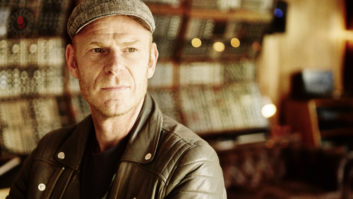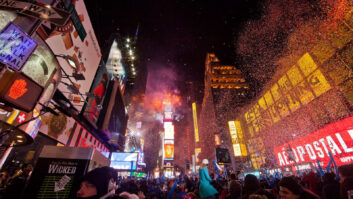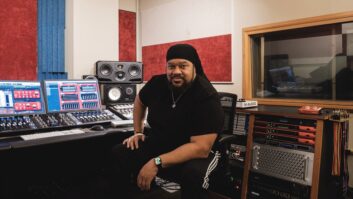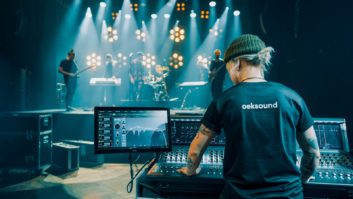The JazzFest Live production team (from left): Eli Kelly, MunckMix chief sound engineer; Peter Munck, MunckMix executive producer; David Foster of Festival Productions; and Rik Reppe, MunckMix artist relations manager
In the wake of Hurricane Katrina, one New Orleans musician vowed, “New Orleans will swing again!” And he’s right. The strength, spirit and soul of the people of New Orleans will make it so. There’s no question that the region’s musical talent will play a substantial role in rebuilding civic pride and once again attracting tourist dollars to the Crescent City. Indeed, the area’s second biggest event (after Mardi Gras, of course), the New Orleans Jazz & Heritage Festival (known far and wide simply as JazzFest), is scheduled to go on as planned, April 26 to May 7, 2006.
JazzFest is a sprawling musical party, complete with the best food, arts and crafts the bayou has to offer. Every year, it brings together disparate Cajun, zydeco, blues, rock ‘n’ roll and jazz artists spread out across the expansive fairgrounds’ many stages. The event had grown steadily through the years and has no difficulty attracting top-drawer acts.
One of those fans drawn by the multitude of JazzFest’s musical and cultural events was Peter Munck. Munck was a management consultant until 2003, when he decided to follow his passion for live music. He started recording The Dead’s live shows on their summer tour in 2003 and distributed the CDs at www.MunckMusic.com/wms, his company’s (MunckMix) Website. Munck knew it would be a massive undertaking to record and distribute the many acts at the New Orleans Jazz & Heritage Festival, but his love of the region’s music spurred him on. Munck received an exclusive agreement to record and distribute the recordings on CD or by direct download from his dedicated online music store (www.JazzFestLive.com) in 2004.
Munck used a Roland VS 2480CD DAW to get rough, on-the-fly recordings for artists who wanted to approve their performance pre-distribution.
“The first thing we did was to get the exclusive rights to record artists and sell the recordings at the venue,” Munck explains. “The fairgrounds is actually a privately held racetrack, and the JazzFest producers, a company called Festival Productions, lease the venue each year. So we had to get permission from both the New Orleans Jazz & Heritage Foundation and Festival Productions.”
As executive producer of the JazzFest Live recordings, Munck also had to get the musicians’ approval for recording and selling their music. With the help of artist relations manager Rik Reppe, Munck negotiated artist compensation and publishing rights with each JazzFest performer. Most artists agreed to terms, but some preferred not to be recorded because of existing contract obligations.
For the 2004 JazzFest recordings, Munck relied on getting a feed from each show’s front-of-house mixer, plus a couple of direct outs from the board. But he vowed to do things differently in 2005. “With a festival where each act only has 30 minutes to set up, there is no time for soundchecks,” Munck explains. “The first two or three songs were often dicey for the front-of-house mixer. We had to get direct feeds from the stage.” So for 2005, Munck acquired six stand-alone Alesis HD-24 ADAT 24-track digital recording rigs to capture performances that were happening simultaneously on multiple stages.
Munck staffed each recording rig with a dedicated engineer who worked with each concert’s monitor mixer to get a stage feed from the monitor mixing consoles. Munck also brought his own microphones (Shure PG-81 and Audix SCX 1) to capture the audience.
The late Clarence “Gatemouth” Brown made his final JazzFest appearance in 2005.
“We relied on feeds from the monitor mix for all vocals and instruments,” he explains. “The only direct mic feeds were for the audience. We typically placed those mics on the edge of the stage pointed toward the audience, rather than in the audience. That way, we didn’t have to adjust for time lags between the mic feeds and the mixer feeds.”
The signal from the monitor board and audience mics went through Behringer ADA8000 8-channel optical preamps and then to Alesis HD-24 ADAT recorders (24 tracks total). Because the MunckMix team was constantly on the go, they relied on the Alesis’ FirePort 1394 interface and a removable hard disk caddy to transport the tracks from the digital recorders to laptop computers in their trailer/mixing/mastering room. Munck also used a Roland VS-2480CD digital audio workstation to get rough, on-the-fly recordings to give to a handful of performers who insisted on approving their performance before it was distributed.
Working out of a two-room trailer on the fairgrounds, Munck and a staff of four other engineers mixed and mastered the recordings on high-powered laptop computers equipped with Mackie Tracktion software. (Some of the mixes were done in Pro Tools, but the majority were done with Tracktion because of its high-speed rendering capability.) They listened to mixes through Roland DS90 near-field monitors. When they were happy with the overall sound, they transferred the mix to Red Book format with WaveLab software. Then they used Plextor CopyWriter 48x DVD/CD burners (20 in all) to duplicate more than 200 CDs per hour.
“We mixed and mastered many of the acts immediately after the show,” Munck says. “Then we produced and packaged the CDs overnight so festival-goers could buy CDs at our merchandising booth at the festival the next day and take them home.”
At last year’s JazzFest, Munck oversaw the recording, mixing and mastering of 57 artist performances from seven different stages. He had a booth on the fairgrounds distributing the CDs, and he was kept busy updating his Website with recordings as they became available. Damon Westjohn, MunckMix operations manager, coordinated CD burning, liner notes with artist and song information, packaging and on-site merchandising.
It was an exhausting 10 days, but it was all worth the effort. “Many people will be attracted by the recordings of the Neville Brothers or The Meters or the Black Crowes,” Munck concludes, “and then they discover all these other great artists, like Anders Osborne and Waylon Thibodeaux and Karl Denson. That makes me feel great!”
In response to Hurricane Katrina, MunckMix is selling a 2005 JazzFest compilation CD with some of the proceeds going to the MusiCares Hurricane Relief Fund.







